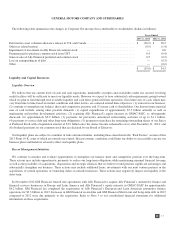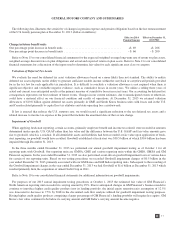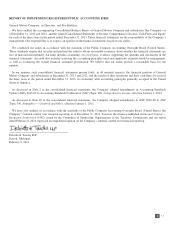General Motors 2013 Annual Report Download - page 46
Download and view the complete annual report
Please find page 46 of the 2013 General Motors annual report below. You can navigate through the pages in the report by either clicking on the pages listed below, or by using the keyword search tool below to find specific information within the annual report.
GENERAL MOTORS COMPANY AND SUBSIDIARIES
We do not have any required contributions payable to our U.S. qualified plans in 2014. We expect to contribute $0.1 billion to our
U.S. non-qualified plans and $0.7 billion to our non-U.S. pension plans in 2014.
Critical Accounting Estimates
The consolidated financial statements are prepared in conformity with U.S. GAAP, which require the use of estimates, judgments
and assumptions that affect the reported amounts of assets and liabilities, the disclosure of contingent assets and liabilities at the date
of the financial statements and the reported amounts of revenues and expenses in the periods presented. We believe that the
accounting estimates employed are appropriate and resulting balances are reasonable; however, due to inherent uncertainties in
making estimates actual results could differ from the original estimates, requiring adjustments to these balances in future periods. We
have discussed the development, selection and disclosures of our critical accounting estimates with the Audit Committee of the Board
of Directors and the Audit Committee has reviewed the disclosures relating to these estimates.
Pensions
The defined benefit pension plans are accounted for on an actuarial basis, which requires the selection of various assumptions,
including an expected long-term rate of return on plan assets and a discount rate. The expected long-term rate of return on U.S. plan
assets that is utilized in determining pension expense is derived from periodic studies, which include a review of asset allocation
strategies, anticipated future long-term performance of individual asset classes, risks using standard deviations and correlations of
returns among the asset classes that comprise the plans’ asset mix. While the studies give appropriate consideration to recent plan
performance and historical returns, the assumptions are primarily long-term, prospective rates of return.
In December 2013 an investment policy study was completed for the U.S. pension plans. The study resulted in new target asset
allocations being approved for the U.S. pension plans with resulting changes to the expected long-term rate of return on assets. The
weighted-average long-term rate of return on assets increased from 5.8% at December 31, 2012 to 6.5% at December 31, 2013 due
primarily to higher yields on fixed income securities.
Another key assumption in determining net pension expense is the assumed discount rate to be used to discount plan obligations.
We estimate this rate for U.S. plans using a cash flow matching approach, which uses projected cash flows matched to spot rates along
a high quality corporate yield curve to determine the present value of cash flows to calculate a single equivalent discount rate.
Significant differences in actual experience or significant changes in assumptions may materially affect the pension obligations. The
effects of actual results differing from assumptions and the changing of assumptions are included in unamortized net actuarial gains and
losses that are subject to amortization to expense over future periods. The unamortized pre-tax actuarial gain (loss) on our pension plans
was $1.4 billion and $(6.2) billion at December 31, 2013 and 2012. The change is due primarily to the increase in discount rates.
The following table illustrates the sensitivity to a change in certain assumptions for the pension plans, holding all other assumptions
constant (dollars in millions):
U.S. Plans Non-U.S. Plans
Effect on 2014
Pension
Expense
Effect on
December 31,
2013 PBO
Effect on 2014
Pension
Expense
Effect on
December 31,
2013 PBO
25 basis point decrease in discount rate .............................. ⳮ$ 50 +$ 1,890 +$ 22 +$ 866
25 basis point increase in discount rate .............................. +$ 50 ⳮ$ 1,830 ⳮ$21 ⳮ$ 821
25 basis point decrease in expected rate of return on assets .............. +$ 150 N/A +$ 36 N/A
25 basis point increase in expected rate of return on assets ............... ⳮ$ 150 N/A ⳮ$ 36 N/A
44
2013 ANNUAL REPORT
























